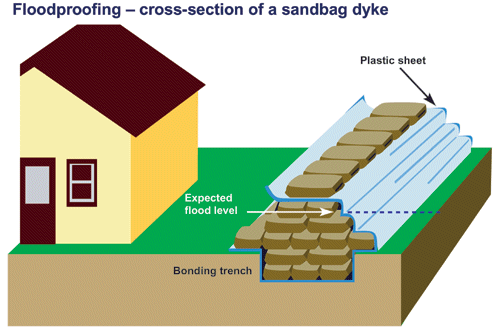Managing Notification and Action During Flood Emergencies
High water events during the spring freshet can be damaging to shorelines, properties, wells, septic systems, etc. Spring flooding can and has affected GLPOA members, as witnessed by the flooding events in 2008 and 2017, which caused major damage for many. The best way to prepare is to be well-informed and to know what you can do to protect your property.
In the fall of 2009, the Golden Lake Property Owners Association helped to initiate an emergency communications system to warn people about flooding potential and to help them to prepare. Since then the system has been refined and is now mostly in the hands of Renfrew Power Generation which manages the levels through adjustments to the dams at Tramore and Golden Lake. As well, since the 2017 flooding event, more methods of emergency management and communication have been established with the MNRF and the local townships, providing a more robust system of communication to property owners.
Here is where to find current information before and during the spring freshet: Renfrew Power Generation Below the water level charts is the list of our partners in the water levels communications group.
Your local township is available to help you with flood-related issues, including sand bags. Note, a new position called an Community Emergency Management Coordinator (CEMC) has been established in many townships in Ontario. One of the roles of this position is to coordinate responses to emergencies affecting Ontario townships, including flooding events.
Killaloe, Hagarty and Richards
- CEMC: Dean Holly, cell 613-401-9073
- Sand bag locations:
* Roads Yard – 16370 Highway 60. Both sand bags and sand are located at the back of the garage.
* Round Lake Fire Hall – 2995 Round Lake Road* Behind the Municipal Office at 1 John Street
* At the intersection of Eno Road and Deer Trail Road
* Near 911 # 156 on Eno Road
* Near 911 # 1433 on Red Rock Road
- CEMC: Stephen Doering, cell 613-639-2760, email cemc@nalgonawil.com
- Sand bag locations:
* Sand dome, Golden Lake village
* Garage, Shaw Woods township office
- CEMC: Doug Buckwald, cell 613-635-3579, email: cemc@eganville.com
The Algonquins of Pikwakanagan First Nation
Filling sandbags
Click here for some instructions on how to fill sandbags.
Sandbag dykes
The most common emergency floodproofing technique entails stacking sandbags in such a way as to form a barrier against rising floodwaters. The bags must be strong enough to hold the sand or fill and withstand contact with water indefinitely. It is best to use burlap and plastic bags designed for that purpose and to use a durable plastic sheet to prevent the seepage of water through the dyke.
Since water exerts pressures against the sandbag dyke, if at all possible a trench should be dug to prevent the dyke from moving. Other methods of anchoring the dyke include placing the bottom of the dyke against or on permanent features, e.g., a ditch, a raised roadbed, a foundation wall etc.
The bags should not be totally filled with sand. This allows one to overlap the other and serves to lock the bags together. In addition, the bags should be placed so that each layer is put at right angles to the layers above and below, adding stability to the structure.
For more detailed information about constructing a dyke, check out the document Sandbag Filling and Placement. This document was created and generously shared by the German Federal Agency for Technical Relief. Thank you!

